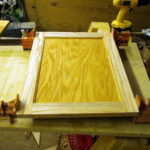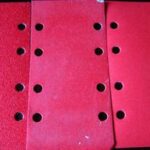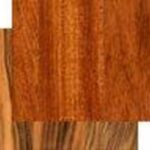Plastic laminate and veneer are used to cover less expensive types of wood, such as plywood or particle board, with a protective, decorative face. Acrylic sheets make shelves, sliding doors, and trim. Here are basic assembly techniques for each material.
Applying Plastic Laminate
Measure and mark the plastic, score the cut-off line with a utility knife, and cut – top side up with a handsaw, top side down with a circular saw. Use a low angle with the handsaw, or a fine-toothed blade with a power saw, to avoid chipping. Thin pieces can simply be scored, then bent to cut.
Check alignment before gluing. Apply contact cement to both surfaces and allow to dry for 20 to 30 minutes. Cover the wood surface with a piece of heavy brown wrapping paper, and lay the glued side of the laminate down on the paper. The glue, if dry enough, should not stick to the paper.
Align all edges, then slowly begin pulling the paper out, pressing the plastic down as you go. A roller is helpful once the laminate is attached. On large surfaces, try using two overlapping sheets of paper, and work one side at a time.
Once it’s laid, laminate can be trimmed to exact size with a router bit or dressed with a fine-toothed file. If you’re laminating the edges as well as the top of a surface, do the edges first and cut the top to fit.
Applying Wood Veneer
In my opinion, applying wafer-thin wood veneer is essentially like applying plastic laminate. Traditionally, wood veneer came in narrow sections; 12″ was the maximum width, and veneering large surfaces was a game of matching seams and edges. Now, there’s a very thin, flexible kind of veneer, available in sizes up to 4′ by 8′, that is applied like plastic laminate.
Based on my experience, the best cutter for veneer is a sharp utility knife or a veneer saw – like a comb with teeth on both sides. Use a carpenter’s square or other metal straightedge as a guide while cutting. Glue with contact cement, following the instructions I have told you above for plastic laminate.
After the veneer is down, roll it carefully to even the surface. Once attached, wood veneers are finished like regular wood. Flexible wood trim, in 1″ or 2″ rolls, is available for veneering edges. It’s made in many hardwood types. Veneer can be trimmed with a router, file, or small (3 ½”) trimming plane.
Cutting Acrylic Sheets
I have experience in cutting, drilling, and bending acrylic sheets to various shapes. To cut 1/8″ or ¼” sheets, score with a plastic scriber and slip a ¾” dowel under the cut; then press down on both sides, holding your hands about 2″ from the intended break. For strips less than 2″ wide, or for sheets thicker than ¼”, use a handsaw with fine teeth or a circular saw with fine teeth.
Curved cuts can be made with a fine-toothed saber saw blade or a coping saw. Holes are drilled in acrylics at slow speeds. Don’t forget to back the hole with a scrap to prevent chipping. Make large holes with a hole saw.
Edges can be filed, sanded, and polished with wet-and-dry sandpaper and a buffing compound.




